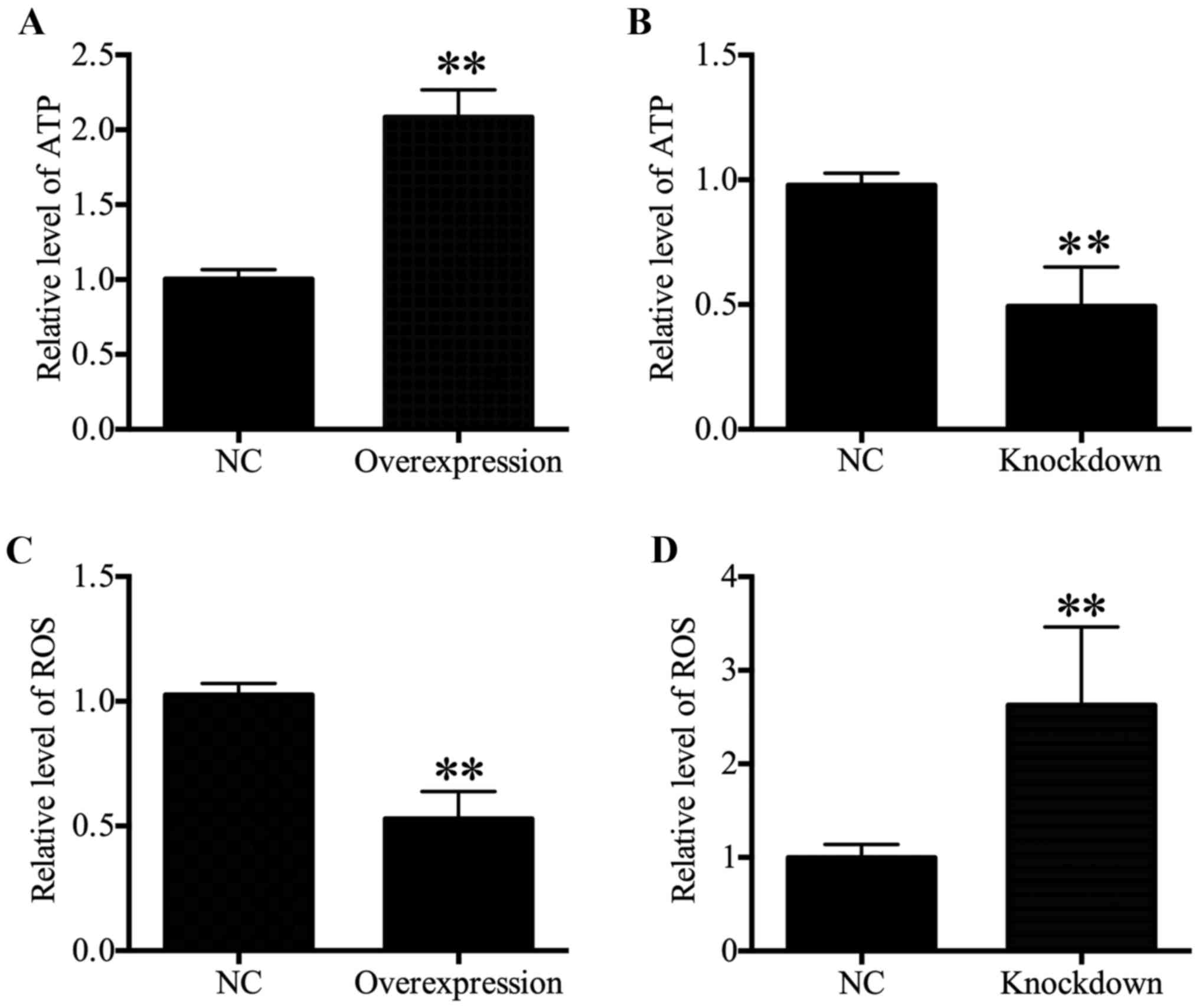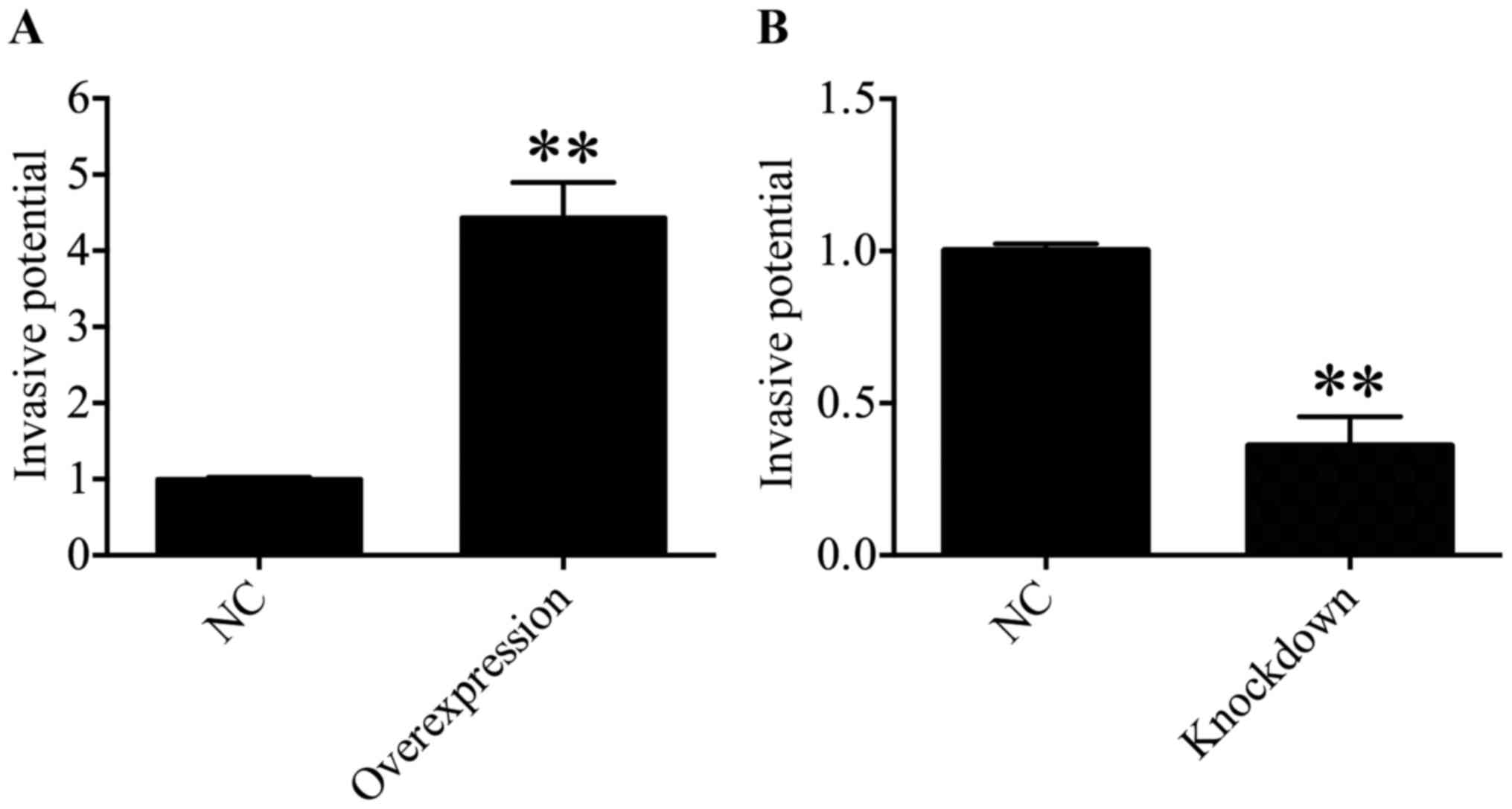|
1
|
Farshidfar Z, Faeghi F, Mohseni M,
Seddighi A, Kharrazi HH and Abdolmohammadi J: Diffusion tensor
tractography in the presurgical assessment of cerebral gliomas.
Neuroradiol J. 27:75–84. 2014. View Article : Google Scholar : PubMed/NCBI
|
|
2
|
Kazakova MH, Staneva DN, Koev IG, Staikov
DG, Mateva N, Timonov PT, Miloshev GA and Sarafian VS: Protein and
mRNA levels of YKL-40 in high-grade glioma. Folia Biol (Praha).
60:261–267. 2014.
|
|
3
|
Chen S, Han M, Chen W, He Y, Huang B, Zhao
P, Huang Q, Gao L, Qu X and Li X: KIF1B promotes glioma migration
and invasion via cell surface localization of MT1-MMP. Oncol Rep.
35:971–977. 2016. View Article : Google Scholar
|
|
4
|
Ortega-Aznar A, Jimenez-Leon P, Martinez E
and Romero-Vidal FJ: Clinico-pathological and molecular aspects of
diagnostic and prognostic value in gliomas. Rev Neurol. 56:161–170.
2013.In Spanish. PubMed/NCBI
|
|
5
|
Waitkus MS, Diplas BH and Yan H:
Isocitrate dehydrogenase mutations in gliomas. Neurooncol.
18:16–26. 2016.
|
|
6
|
Lin M, Zhu Q, Wang J, Yang W, Fan H, Yi J
and Jiang M: Molecules involved in acrosomal exocytosis and
cortical granule exocytosis. Biotarget. 1:112017. View Article : Google Scholar
|
|
7
|
Lindemann C, Hackmann O, Delic S, Schmidt
N, Reifenberger G and Riemenschneider MJ: SOCS3 promoter
methylation is mutually exclusive to EGFR amplification in gliomas
and promotes glioma cell invasion through STAT3 and FAK activation.
Acta Neuropathol. 122:241–251. 2011. View Article : Google Scholar : PubMed/NCBI
|
|
8
|
Fang Q, Xu T, Wu C, Zhou S and Sun H:
Biotargets in neural regeneration. Biotarget. 1:62017. View Article : Google Scholar
|
|
9
|
Crow M, Khovanov N, Kelleher JH, Sharma S,
Grant AD, Bogdanov Y, Wood JN, McMahon SB and Denk F: HDAC4 is
required for inflammation-associated thermal hypersensitivity.
FASEB J. 29:3370–3378. 2015. View Article : Google Scholar : PubMed/NCBI
|
|
10
|
Cohen TJ, Choi MC, Kapur M, Lira VA, Yan Z
and Yao TP: HDAC4 regulates muscle fiber type-specific gene
expression programs. Mol Cells. 38:343–348. 2015. View Article : Google Scholar : PubMed/NCBI
|
|
11
|
Zhou J, Li P, Chen Q, Wei X, Zhao T, Wang
Z and Wei L: Mitogen-activated protein kinase p38 induces HDAC4
degradation in hypertrophic chondrocytes. Biochim Biophys Acta.
1853:370–376. 2015. View Article : Google Scholar :
|
|
12
|
Xiao H, Jiao J, Wang L, O’Brien S, Newick
K, Wang LC, Falkensammer E, Liu Y, Han R, Kapoor V, et al: HDAC5
controls the functions of Foxp3(+) T-regulatory and CD8(+) T cells.
Int J Cancer. 138:2477–2486. 2016. View Article : Google Scholar
|
|
13
|
Hsieh TH, Hsu CY, Tsai CF, Long CY, Chai
CY, Hou MF, Lee JN, Wu DC, Wang SC and Tsai EM: miR-125a-5p is a
prognostic biomarker that targets HDAC4 to suppress breast
tumorigenesis. Oncotarget. 6:494–509. 2015. View Article : Google Scholar :
|
|
14
|
Wei JY, Li WM, Zhou LL, Lu QN and He W:
Melatonin induces apoptosis of colorectal cancer cells through
HDAC4 nuclear import mediated by CaMKII inactivation. J Pineal Res.
58:429–438. 2015. View Article : Google Scholar : PubMed/NCBI
|
|
15
|
Amodio N, Stamato MA, Gullà AM, Morelli E,
Romeo E, Raimondi L, Pitari MR, Ferrandino I, Misso G, Caraglia M,
et al: Therapeutic targeting of miR-29b/HDAC4 epigenetic loop in
multiple myeloma. Mol Cancer Ther. 15:1364–1375. 2016. View Article : Google Scholar : PubMed/NCBI
|
|
16
|
Vallabhapurapu SD, Noothi SK, Pullum DA,
Lawrie CH, Pallapati R, Potluri V, Kuntzen C, Khan S, Plas DR,
Orlowski RZ, et al: Transcriptional repression by the
HDAC4-RelB-p52 complex regulates multiple myeloma survival and
growth. Nat Commun. 6:84282015. View Article : Google Scholar : PubMed/NCBI
|
|
17
|
Zeng LS, Yang XZ, Wen YF, Mail SJ, Wang
MH, Zhang MY, Zheng XF and Wang HY: Overexpressed HDAC4 is
associated with poor survival and promotes tumor progression in
esophageal carcinoma. Aging (Albany NY). 8:1236–1249. 2016.
View Article : Google Scholar
|
|
18
|
Kaowinn S, Jun SW, Kim CS, Shin DM, Hwang
YH, Kim K, Shin B, Kaewpiboon C, Jeong HH, Koh SS, et al: Increased
EGFR expression induced by a novel oncogene, CUG2, confers
resistance to doxorubicin through Stat1-HDAC4 signaling. Cell Oncol
(Dordr). 40:549–561. 2017. View Article : Google Scholar
|
|
19
|
Louis DN, Ohgaki H, Wiestler OD, Cavenee
WK, Burger PC, Jouvet A, Scheithauer BW and Kleihues P: The 2007
WHO classification of tumours of the central nervous system. Acta
Neuropathol. 114:97–109. 2007. View Article : Google Scholar : PubMed/NCBI
|
|
20
|
Henriksen S, Tylden GD, Dumoulin A, Sharma
BN, Hirsch HH and Rinaldo CH: The human fetal glial cell line SVG
p12 contains infectious BK polyomavirus. J Virol. 88:7556–7568.
2014. View Article : Google Scholar : PubMed/NCBI
|
|
21
|
George J, Gonçalves FQ, Cristóvão G,
Rodrigues L, Meyer Fernandes JR, Gonçalves T, Cunha RA and Gomes
CA: Different danger signals differently impact on microglial
proliferation through alterations of ATP release and extracellular
metabolism. Glia. 63:1636–1645. 2015. View Article : Google Scholar : PubMed/NCBI
|
|
22
|
Kühn F: New insights into the interaction
between ADP-ribose and human TRPM2 channel. Biotarget. 1:142017.
View Article : Google Scholar
|
|
23
|
Almontashiri NA, Chen HH, Mailloux RJ,
Tatsuta T, Teng AC, Mahmoud AB, Ho T, Stewart NA, Rippstein P,
Harper ME, et al CARDIoGRAM Consortium: SPG7 variant escapes
phosphorylation-regulated processing by AFG3L2, elevates
mitochondrial ROS, and is associated with multiple clinical
phenotypes. Cell Reports. 7:834–847. 2014. View Article : Google Scholar : PubMed/NCBI
|
|
24
|
Jiang K, Wang W, Jin X, Wang Z, Ji Z and
Meng G: Silibinin, a natural flavonoid, induces autophagy via
ROS-dependent mitochondrial dysfunction and loss of ATP involving
BNIP3 in human MCF7 breast cancer cells. Oncol Rep. 33:2711–2718.
2015. View Article : Google Scholar : PubMed/NCBI
|
|
25
|
Brookes PS, Yoon Y, Robotham JL, Anders MW
and Sheu SS: Calcium, ATP, and ROS: A mitochondrial love-hate
triangle. Am J Physiol Cell Physiol. 287:C817–C833. 2004.
View Article : Google Scholar : PubMed/NCBI
|
|
26
|
Van de Wouwer M, Couzinié C,
Serrano-Palero M, González-Fernández O, Galmés-Varela C,
Menéndez-Antolí P, Grau L and Villalobo A: Activation of the
BRCA1/Chk1/p53/p21(Cip1/ Waf1) pathway by nitric oxide and cell
cycle arrest in human neuroblastoma NB69 cells. Nitric Oxide.
26:182–191. 2012. View Article : Google Scholar : PubMed/NCBI
|
|
27
|
Wang J, Wang G and Khan MF: Disorder of
G2-M Checkpoint control in aniline-induced cell proliferation in
rat spleen. PLoS One. 10:e01314572015. View Article : Google Scholar : PubMed/NCBI
|
|
28
|
Yi X, Li Y, Zai H, Long X and Li W: KLF8
knockdown triggered growth inhibition and induced cell phase arrest
in human pancreatic cancer cells. Gene. 585:22–27. 2016. View Article : Google Scholar : PubMed/NCBI
|
|
29
|
Park IH, Kang JH, Shin JM and Lee HM:
Trichostatin A inhibits epithelial mesenchymal transition induced
by TGF-β1 in airway epithelium. PLoS One. 11:e01620582016.
View Article : Google Scholar
|
|
30
|
Tu Y, Gao X, Li G, Fu H, Cui D, Liu H, Jin
W and Zhang Y: MicroRNA-218 inhibits glioma invasion, migration,
proliferation, and cancer stem-like cell self-renewal by targeting
the polycomb group gene Bmi1. Cancer Res. 73:6046–6055. 2013.
View Article : Google Scholar : PubMed/NCBI
|
|
31
|
Le Rhun E, Taillibert S and Chamberlain
MC: Anaplastic glioma: Current treatment and management. Expert Rev
Neurother. 15:601–620. 2015. View Article : Google Scholar : PubMed/NCBI
|
|
32
|
Wirsching HG, Happold C, Roth P and Weller
M: Management of diffusely infiltrating glioma in the elderly. Curr
Opin Oncol. 27:502–509. 2015. View Article : Google Scholar : PubMed/NCBI
|
|
33
|
Liu Q, Zheng JM, Chen JK, Yan XL, Chen HM,
Nong WX and Huang HQ: Histone deacetylase 5 promotes the
proliferation of glioma cells by upregulation of Notch 1. Mol Med
Rep. 10:2045–2050. 2014. View Article : Google Scholar : PubMed/NCBI
|
|
34
|
Kang ZH, Wang CY, Zhang WL, Zhang JT, Yuan
CH, Zhao PW, Lin YY, Hong S, Li CY and Wang L: Histone deacetylase
HDAC4 promotes gastric cancer SGC-7901 cells progression via p21
repression. PLoS One. 9:e988942014. View Article : Google Scholar : PubMed/NCBI
|
|
35
|
Kaewpiboon C, Srisuttee R, Malilas W, Moon
J, Oh S, Jeong HG, Johnston RN, Assavalapsakul W and Chung YH:
Upregulation of Stat1-HDAC4 confers resistance to etoposide through
enhanced multidrug resistance 1 expression in human A549 lung
cancer cells. Mol Med Rep. 11:2315–2321. 2015. View Article : Google Scholar
|
|
36
|
Isaacs JT, Antony L, Dalrymple SL, Brennen
WN, Gerber S, Hammers H, Wissing M, Kachhap S, Luo J, Xing L, et
al: Tasquinimod Is an aAllosteric modulator of HDAC4 survival
signaling within the compromised cancer microenvironment. Cancer
Res. 73:1386–1399. 2013. View Article : Google Scholar
|
|
37
|
Stronach EA, Alfraidi A, Rama N, Datler C,
Studd JB, Agarwal R, Guney TG, Gourley C, Hennessy BT, Mills GB, et
al: HDAC4-regulated STAT1 activation mediates platinum resistance
in ovarian cancer. Cancer Res. 71:4412–4422. 2011. View Article : Google Scholar : PubMed/NCBI
|
|
38
|
Chen EI: Mitochondrial dysfunction and
cancer metastasis. J Bioenerg Biomembr. 44:619–622. 2012.
View Article : Google Scholar : PubMed/NCBI
|
|
39
|
Mottet D, Pirotte S, Lamour V, Hagedorn M,
Javerzat S, Bikfalvi A, Bellahcène A, Verdin E and Castronovo V:
HDAC4 represses p21(WAF1/Cip1) expression in human cancer cells
through a Sp1-dependent, p53-independent mechanism. Oncogene.
28:243–256. 2009. View Article : Google Scholar
|
|
40
|
Park SY, Jun JA, Jeong KJ, Heo HJ, Sohn
JS, Lee HY, Park CG and Kang J: Histone deacetylases 1, 6 and 8 are
critical for invasion in breast cancer. Oncol Rep. 25:1677–1681.
2011.PubMed/NCBI
|
|
41
|
Ahn MY, Kang DO, Na YJ, Yoon S, Choi WS,
Kang KW, Chung HY, Jung JH, Min S and Kim HS: Histone deacetylase
inhibitor, apicidin, inhibits human ovarian cancer cell migration
via class II histone deacetylase 4 silencing. Cancer Lett.
325:189–199. 2012. View Article : Google Scholar : PubMed/NCBI
|


















